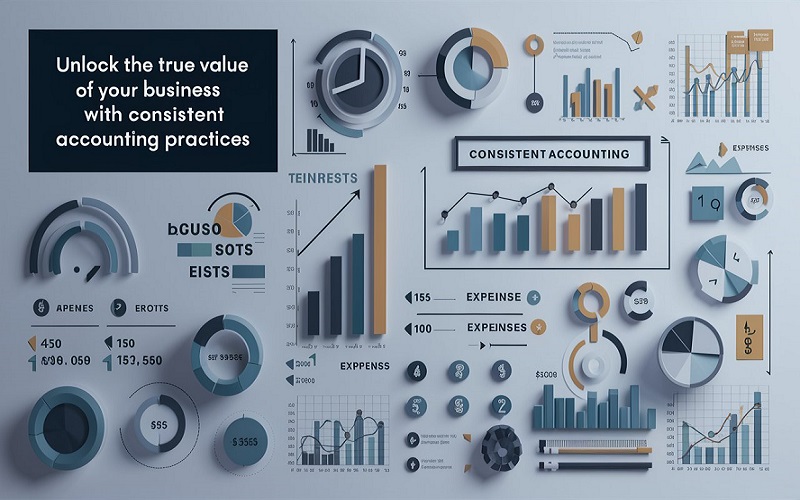
Retirement Riches: The Best Self-Employed Plans Revealed (Solo 401k, Solo Roth 401k, Roth IRA, SEP IRA)
November 8, 2024
Financial Forecasting: Predicting Your Business’s Future
November 21, 2024In an increasingly volatile business landscape, future-proofing your business has become more critical than ever. Strategic planning that anticipates market shifts, embraces innovation, and ensures financial resilience can help businesses not only survive but thrive for decades. This guide provides a comprehensive, step-by-step framework for developing a strategic plan to position your business for long-term success.
Introduction to Strategic Planning for Future-Proofing
Future-proofing is essential for sustainable growth, ensuring businesses are agile and ready to face evolving market challenges. By embracing strategic planning, companies can create a proactive roadmap to strengthen resilience, adapt to shifts, and remain competitive.
Why Future-Proofing Matters
In times of uncertainty, businesses that have prepared for disruption fare better. Future-proofing allows a business to be forward-thinking, aligning with emerging opportunities and tackling risks in a calculated manner.
Identifying Trends and Analyzing Market Shifts
Understanding current and emerging trends is vital for businesses aiming to remain relevant in the future. By keeping a pulse on industry changes, companies can proactively adapt and harness growth opportunities. Here’s how:
Researching Market Trends and Consumer Behavior
Begin by identifying shifts in your industry, such as evolving consumer preferences, technological advancements, and economic factors. Consider the following:
- Industry Reports and Market Data: Consult market research and analytics reports from reputable sources to uncover insights into consumer trends, competitor behavior, and industry shifts.
- Social Listening and Customer Feedback: Use social media analytics and direct customer feedback to stay in tune with changing preferences and emerging needs.
Conducting a SWOT Analysis for Market Positioning
A SWOT analysis (Strengths, Weaknesses, Opportunities, Threats) can help you understand your company’s current positioning and potential for future growth.
- Strengths and Weaknesses: Identify where your business excels and areas needing improvement.
- Opportunities and Threats: Recognize new opportunities, such as unmet customer needs or technological advancements, and assess external threats, like economic shifts or new competitors.
Analyzing Competitor and Industry Landscape
Competitor analysis offers insights into how other businesses adapt to change and where gaps exist in the market. By analyzing competitors’ strengths and weaknesses, you can pinpoint where your business can differentiate itself or innovate.
Assessing Internal Strengths and Weaknesses
A clear understanding of your internal resources and capabilities is crucial to creating a resilient strategy. This process helps ensure you’re leveraging your business’s unique strengths while addressing areas that may hinder growth.
Identifying Core Competencies
Core competencies are your company’s unique abilities that provide value and differentiate you from competitors. Evaluate aspects like:
- Product Quality and Innovation: What unique qualities make your offerings stand out?
- Customer Relationships: How well does your business connect with its target audience?
- Operational Efficiency: Are there areas where your processes could be streamlined or improved?
Recognizing Internal Challenges
Acknowledging and addressing internal weaknesses is essential for long-term success. Common areas for improvement might include outdated technology, skill gaps within teams, or inefficiencies in workflow. Addressing these challenges early can prevent them from becoming obstacles to growth.
Setting Clear, Forward-Thinking Goals
Future-proofing requires setting goals that align with both immediate and long-term objectives. The most effective goals are those that push your business towards future readiness without losing sight of current demands.
Creating Realistic yet Ambitious Goals
When setting goals, ensure they’re both aspirational and achievable. Effective goals should be:
- Specific: Clearly define what the goal is and how you’ll measure success.
- Aligned with Market Trends: Goals that reflect industry insights help keep your business in step with, or ahead of, the competition.
- Measurable and Time-bound: Use metrics and deadlines to ensure accountability and tracking of progress.
Examples of Future-Focused Business Goals
Some examples of forward-thinking goals could include:
- Expanding into new markets based on emerging trends.
- Increasing digital presence or online revenue by a set percentage within two years.
- Investing in sustainability practices, aiming for carbon neutrality within a specific timeframe.

Creating a Flexible Strategic Framework
Having a flexible, adaptable plan enables your business to respond swiftly to unexpected changes while keeping sight of long-term objectives.
Developing Adaptable Strategic Plans
Instead of rigid goals, outline a flexible plan with room for adjustments. An adaptable framework allows your business to pivot in response to new challenges or opportunities.
Establishing Contingencies for Different Scenarios
Contingency planning prepares your business for various outcomes:
- Best-Case Scenarios: How will you scale operations if a growth surge occurs?
- Worst-Case Scenarios: What steps will you take in the event of economic downturns or supply chain disruptions?
Innovation as a Core Component of Future-Proofing
Innovation drives longevity in business, helping companies to evolve and stay competitive. Embedding innovation into your business model encourages a forward-thinking approach across all levels of the organization.
Fostering a Culture of Innovation
Encourage team members to bring creative solutions to the table by:
- Providing Time and Resources: Allocate time and budget for employees to experiment with new ideas.
- Rewarding Innovative Thinking: Recognize and reward team members who contribute unique, actionable ideas.
Balancing Risk and Innovation
Innovation involves taking risks, but it’s important to manage this risk:
- Pilot Programs: Test new ideas on a small scale to assess potential impacts before a full rollout.
- Risk Management: Ensure contingency plans are in place if a new initiative does not yield expected results.
Embracing Digital Transformation
Technology plays a central role in modern business, enabling better data analytics, automation, and customer engagement.
Analyzing Necessary Tech Investments
Determine which technologies align with your business needs and growth objectives. Consider:
- Automation Tools: These can streamline repetitive tasks, reducing operational costs.
- Data Analytics: Insights from data can guide strategic decision-making, improve customer targeting, and increase operational efficiency.
Leveraging AI and Automation for Growth
AI and automation offer numerous possibilities for enhancing productivity, personalizing customer experiences, and gaining competitive insights. Investing in these tools now can set your business apart as technology continues to evolve.

Workforce Planning and Development
A skilled, adaptable workforce is essential for future-proofing. By investing in your employees, you ensure your business has the talent to navigate new challenges and capitalize on emerging opportunities.
Building Skills for the Future
Identify key skills that will be relevant in the coming years, such as digital literacy, data analysis, and strategic thinking. Offering training and development programs helps employees acquire these skills and contributes to your company’s growth.
Fostering a Culture of Continuous Learning
Create a culture where learning and development are valued. Encourage employees to take advantage of training opportunities and explore new areas relevant to their roles.
Sustainable Practices for Long-Term Success
Sustainability is no longer optional; consumers, investors, and employees increasingly prioritize environmental and social responsibility.
Implementing Eco-Friendly Practices
Identify ways to reduce waste, conserve resources, and minimize your carbon footprint. Sustainable practices not only appeal to eco-conscious consumers but can also lead to cost savings.
Connecting Sustainability to Competitive Advantage
Sustainable practices can differentiate your brand and improve customer loyalty. Showcase your commitment to sustainability through transparent reporting and actively engaging in environmentally friendly initiatives.
Managing Financial Resilience
Financial resilience is a cornerstone of a future-proof business. A robust financial strategy ensures your business can weather economic changes and remain financially healthy.
Building a Diverse Revenue Model
Diversifying income streams, whether through additional product offerings or new markets, creates financial stability. This way, if one area experiences a downturn, your business can rely on other revenue sources.
Establishing Financial Safeguards
Financial safeguards, such as emergency funds and credit lines, can provide a buffer in times of crisis. Plan for various scenarios to ensure cash flow is managed effectively.
Implementing and Monitoring Strategic Plans
Strategic plans must be implemented thoughtfully and continuously monitored to ensure effectiveness.
Setting Up Key Performance Indicators (KPIs)
Identify metrics that align with your strategic goals, such as revenue growth, customer retention, and operational efficiency. Regularly reviewing KPIs will provide insights into how well the strategy is working and where adjustments may be needed.
Adapting Plans Based on Performance Metrics
Regular evaluations enable you to refine your strategic plan based on performance data. This adaptive approach ensures that your business remains aligned with its objectives even as circumstances change.
Creating a Strong Customer-Centric Approach
A customer-first mindset enhances loyalty and satisfaction, keeping your business resilient even during times of market change.
Gathering Customer Feedback to Drive Decisions
Use customer feedback to guide decision-making. This can inform product development, improve customer service, and ensure your offerings meet current demands.
Evaluating Risks and Building Contingencies
Understanding and preparing for potential risks is crucial in future-proofing. By assessing various threats, you can create proactive plans to mitigate them.
Developing a Crisis Management Plan
A crisis management plan outlines steps to take in emergencies, helping to minimize the impact of unexpected events on your business.
Case Studies of Future-Proofed Companies
Exploring case studies of businesses that successfully future-proofed themselves provides valuable insights into effective strategies and common pitfalls to avoid.
Frequently Asked Questions (FAQs)
- Q: What does it mean to future-proof a business?
- A: Future-proofing involves creating strategies that help a business remain resilient and adaptable in a changing market.
- Q: How can small businesses future-proof themselves?
- A: Small businesses can future-proof by focusing on flexibility, customer-centric approaches, and by embracing technology and innovation.
Conclusion
Future-proofing your business is an ongoing process that requires vigilance, adaptability, and a commitment to strategic planning. By following these steps, you can position your company for success, navigate challenges with confidence, and thrive in an unpredictable future.
Resources
Market Research and Industry Trends
- Statista provides reliable market data, industry trends, and consumer insights, valuable for companies looking to stay updated on evolving market conditions.
Implementing Digital Transformation
- McKinsey’s insights on digital transformation cover how companies can effectively integrate technology into their operations to remain competitive and adaptive.
Best Practices for Sustainability in Business
- UNEP’s report on sustainable business practices provides guidance on incorporating eco-friendly strategies that support long-term resilience and appeal to eco-conscious consumers.
DISCLAIMER: The information in this article is for informational purposes only and is not meant to take the place of legal and accounting advice.




